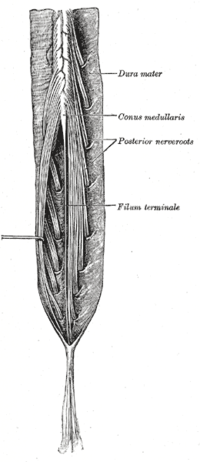
Photo from wikipedia
Abstract Rationale: The most common fractures of the spine are associated with the thoracolumbar junction (T10–L2). And burst fractures make up 15% of all traumatic thoracolumbar fractures, which are often… Click to show full abstract
Abstract Rationale: The most common fractures of the spine are associated with the thoracolumbar junction (T10–L2). And burst fractures make up 15% of all traumatic thoracolumbar fractures, which are often accompanied by neurological deficits and require open surgeries. Common surgeries include either anterior, posterior or a combination of these approaches. Here, we report the first attempt to treat thoracolumbar burst fracture (TLBF) with severe neurologic deficits by percutaneous pedicle screw fixation (PPSF) and transforaminal endoscopic spinal canal decompression (TESCD). Patient concerns: A 46-year-old Chinese woman suffered from severe lower back pain with grade 0 muscle strength of lower limbs, without any sensory function below the injury level, with an inability to urinate or defecate after a motor vehicle accident. Imaging studies confirmed that she had Magerl type A 3.2 L1 burst fracture. Diagnoses: Burst fracture at L1. Interventions: The patient underwent PPSF at the level of T12 to L2, but her neurological function did not fully recover after the operation. One week after the injury, we performed TESCD on her. Outcomes: There was an immediate improvement in her neurological function in just 1 day after 2-stage operation. During the 6-month follow-up period, her neurological functions gradually recovered, and she was able to defecate and urinate. At the last follow-up visit, her spinal cord function was assessed to be at Frankel grade D. Lessons: PPSF plus TESCD can achieve complete spinal cord decompression, promote neurological recovery, and is therefore an effective method for the treating lumbar burst fractures with severe neurologic deficits.
Journal Title: Medicine
Year Published: 2020
Link to full text (if available)
Share on Social Media: Sign Up to like & get
recommendations!